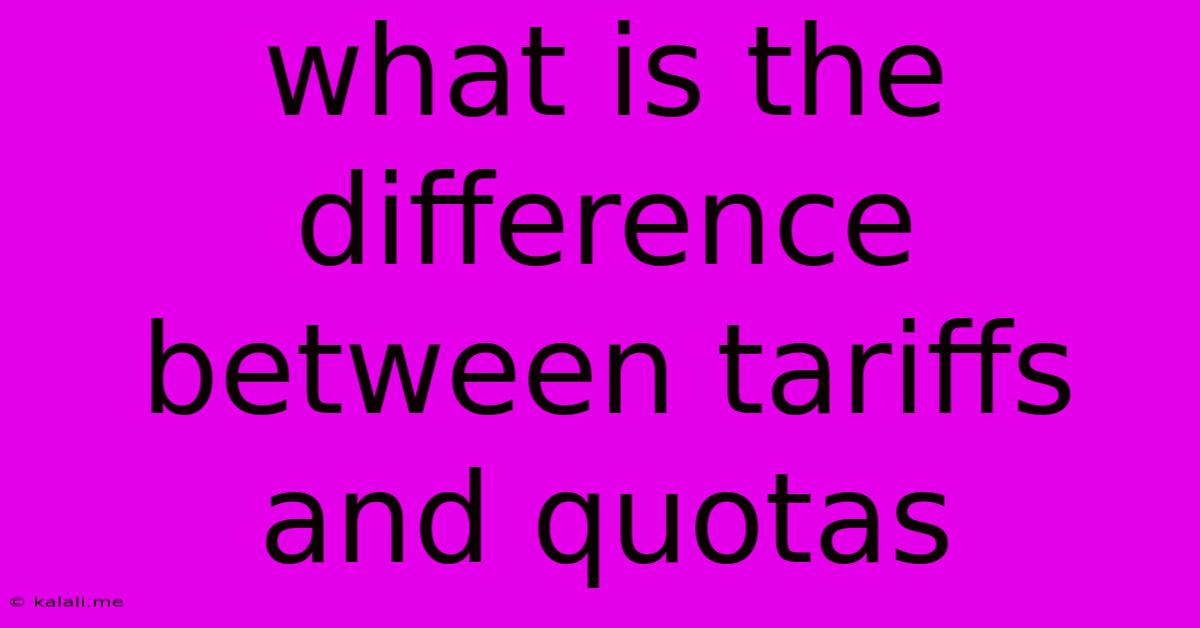What Is The Difference Between Tariffs And Quotas
Kalali
Jun 13, 2025 · 3 min read

Table of Contents
Tariffs vs. Quotas: Understanding the Key Differences in Trade Restrictions
Meta Description: Confused about tariffs and quotas? This article clearly explains the differences between these two common trade restriction methods, highlighting their impacts on domestic industries and consumers. Learn how they affect prices, import volumes, and overall market dynamics.
Both tariffs and quotas are tools governments use to control the flow of imported goods, protecting domestic industries from foreign competition. However, they achieve this protection through different mechanisms, leading to distinct economic consequences. Understanding the core differences between tariffs and quotas is crucial for anyone interested in international trade and economic policy.
What is a Tariff?
A tariff is a tax imposed on imported goods. When goods enter a country, the importer must pay a tariff to the government, increasing the cost of the imported product. This increase makes imported goods more expensive for consumers, potentially boosting demand for domestically produced substitutes. The amount of the tariff is usually expressed as a percentage of the good's value (ad valorem tariff) or a fixed amount per unit (specific tariff).
Key characteristics of tariffs:
- Revenue Generation: Tariffs generate revenue for the government, contributing to public funds.
- Price Increase: They directly increase the price of imported goods, making them less competitive.
- Adjustable Levels: Governments can easily adjust tariff rates, increasing or decreasing them depending on economic conditions and policy goals. This flexibility allows for targeted interventions.
- Predictable Impact (Generally): The impact of tariffs on prices is generally predictable, as the tax amount is known.
What is a Quota?
A quota is a quantitative restriction on the amount of a specific good that can be imported into a country during a given period. Once the quota is filled, no further imports of that good are allowed, regardless of demand. This creates an artificial scarcity, driving up prices for the imported product. Quotas can be allocated on a first-come, first-served basis or through a licensing system.
Key characteristics of quotas:
- No Revenue Generation (Directly): Quotas do not directly generate revenue for the government. Any price increase goes to the importer or foreign producer.
- Price Increase (Indirectly): They indirectly increase prices through limited supply; higher demand meets a constrained supply.
- Less Flexibility: Adjusting quotas requires changing regulations, a more complex and less flexible process than adjusting tariff rates.
- Unpredictable Market Dynamics: The impact on prices can be less predictable because the market supply is artificially limited, leading to potentially volatile price fluctuations.
- Potential for Rent-Seeking: Quotas can create opportunities for rent-seeking behavior, where importers try to secure import licenses at a premium.
Comparing Tariffs and Quotas: A Side-by-Side Look
| Feature | Tariff | Quota |
|---|---|---|
| Type | Tax on imports | Quantitative restriction on imports |
| Impact on Price | Direct increase | Indirect increase (due to scarcity) |
| Revenue | Generates revenue for the government | No direct revenue generation |
| Flexibility | Highly adjustable | Less flexible, requires regulatory change |
| Predictability | Generally predictable price impact | Less predictable price impact |
| Market Distortion | Less extreme market distortion | More extreme market distortion |
Which is Better? Neither is inherently "better".
The choice between a tariff and a quota depends on the specific policy goals of the government. Tariffs generate revenue and offer more flexibility, while quotas can provide more direct control over import volumes. However, both methods distort market mechanisms and can lead to negative consequences such as higher prices for consumers, reduced consumer choice, and retaliatory measures from other countries. The overall economic impact of either policy is a complex issue with potential winners and losers. A well-informed analysis considering all economic factors is necessary before implementing either a tariff or a quota.
Latest Posts
Latest Posts
-
Ammeter Connected In Series Or Parallel
Jun 14, 2025
-
Least Common Multiple Of 6 9 And 15
Jun 14, 2025
-
What Is The Shortcut To Delete
Jun 14, 2025
-
What Is The Major Product Obtained From The Following Reaction
Jun 14, 2025
-
Measure Of The Force Of Gravity On An Object
Jun 14, 2025
Related Post
Thank you for visiting our website which covers about What Is The Difference Between Tariffs And Quotas . We hope the information provided has been useful to you. Feel free to contact us if you have any questions or need further assistance. See you next time and don't miss to bookmark.